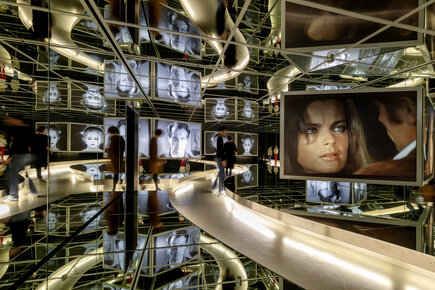The exhibition design refers to the “team house” layout developed for Berlin’s current school-building campaign. Visitors can withdraw to the niches in the pavilion’s façade where texts, photographs, drawings, videos, and audio recordings are presented. The middle of the space remains empty as a “forum” and is available to cooperation partners. The façade of the classroom serves as a surface for the display of large images.
Inspired by a documentary video work made by students from the Alice-Salomon-Hochschule (ASH) about Top Manta, a fashion label founded by migrants in Barcelona, the artist Margarete Kiss and pupils from the Caspar-David-Friedrich-Schule show results from their screen-printing workshop on the theme of labor migration. Artist Juan Camilo Alfonso and children from the refugee shelter at Maxie-Wander-Strasse 78 present their cartogram “Where can/should we play?”, a map marking the improvised, sometimes hidden places where the children play in the shelter’s grounds.
Artists Adam Page and Eva Hertzsch and students Hendrik Steuernagel and Jasper Krause present photographs and a video from their extended visit to Laborschule Bielefeld (Bielefeld Laboratory School) that is considered an example of best practice for the New School movement. Page and Hertzsch are also showing The Last Mile-Güterversorgung nach dem Dieselverbot, a short film they made together with students from the Wolfgang-Amadeus-Mozart-Schule and the Victor-Klemperer-Kolleg in Hellersdorf. In the film, the students move a portable shipping container from a logistics hub in Brandenburg to a shopping center in Marzahn using public transport.
In addition, Steuernagel and Krause use graphics and models to present parts of their MA dissertation at the Institute for Architecture of Berlin’s Technical University, a study comparing the CO2 footprint of building a new school with that of renovation.
The artists’ collective ~pes, Conny Kahl from the association Naturschutzinitiative, and elementary school pupils from Grundschule am Schleipfuhl give initial insights into their underground studies of the park. For their school project “In die Untergründe lauschen” (Listening to the depths), small groups of children listen to one square meter of ground over four seasons, developing a sound composition to be completed by December 2024.
The outside walls of the pavilion show two works: Page & Hertzsch, Steuernagel & Krause, and a year-nine class from Konrad-Wachsmann-Schule present “Jeden Freitag Ausflug” (Excursion Every Friday) a work with ideas for an innovative open-plan education campus on and around the park. And the Arbeitskreis Schule der Zukunft presents a graphical summary of three workshops on the question of how schools in the future might adapt with care to local conditions, be they architectural, curricular, ecological, or social.
Representatives from station urbaner kulturen/nGbK Hellersdorf, from Alice Salomon Hochschule Berlin (ASH), and from the Boulevard Kastanienallee Neighborhood Council have been working for two years with local residents and schools, with representatives of the district and municipal administrations, and with experts from the fields of education, school building, social affairs, and the environment on an innovative, inclusive model for “Education of the Future for Hellersdorf.”
On a small scale, the project explores ways for “education of the future” to adapt to the natural and social space of the park. This resulted in a place of dialog where three models—neighborhood schools, environmental schools, and university schools—were tested with regard to their architectural, educational, and social concepts.
These three school models are coming together in Hellersdorf as LABORSCHULE BERLIN (Berlin School Laboratory). The exhibition location itself is also programmatic, as the trade-fair pavilion, designed by Heinz Scheid for Dresdner Bank in 1971, reflects the formal idiom of the 1970s, thus evoking the utopian educational concepts associated with that period: comprehensive schools and education for all. Opposite the park, there is also a standard-type East German school that is currently being used as a shelter for refugees, whose inhabitants contributed to the exhibition.
The results of cooperation with civil society actors presented in the exhibition are intended to set in motion a process of making proposals for a new school to be built in the park as part of Berlin’s current school-building campaign.
Exhibition with Juan Camilo Alfonso, Gemeinschaftsunterkunft Maxie-Wander-Straße, Grundschule am Schleipfuhl, Eva Hertzsch & Adam Page, Alice Salomon Hochschule, Margarete Kiss, Victor-Klemperer-Kolleg, Jasper Krause & Hendrik Steuernagel, ~pes & Conny Kahl, Caspar-David-Friedrich-Schule, Wolfgang-Amadeus-Mozart-Schule, Konrad-Wachsmann-Schule, Wuhletaler Fotofreunde and AK Schule der Zukunft (Architects for Future, Fridays for Future Ma-He, Kontextschule UDK, Marille Schule et al.).
nGbK work group station urbaner kulturen: Jochen Becker, Eva Hertzsch, Margarete Kiss, Constanze Musterer, Adam Page, Ralf Wedekind with Juan Camilo Alfonso
The exhibition LABORSCHULE BERLIN is funded by the program „Sozialer Zusammenhalt“ (social cohesion) of the Senate Department for Urban Development, Building and Housing.
